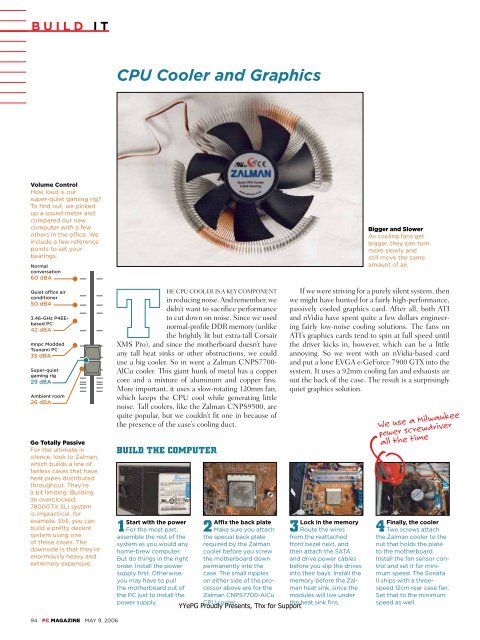Unauthorized - Parent Directory - Support
Unauthorized - Parent Directory - Support
Unauthorized - Parent Directory - Support
You also want an ePaper? Increase the reach of your titles
YUMPU automatically turns print PDFs into web optimized ePapers that Google loves.
BUILD IT<br />
CPU Cooler and Graphics<br />
Volume Control<br />
How loud is our<br />
super-quiet gaming rig?<br />
To find out, we picked<br />
up a sound meter and<br />
compared our new<br />
computer with a few<br />
others in the office. We<br />
include a few reference<br />
points to set your<br />
bearings.<br />
Normal<br />
conversation<br />
60 dBA<br />
Quiet office air<br />
conditioner<br />
50 dBA<br />
3.46-GHz P4EEbased<br />
PC<br />
42 dBA<br />
mnpc Modded<br />
Tsunami PC<br />
35 dBA<br />
Super-quiet<br />
gaming rig<br />
29 dBA<br />
Ambient room<br />
26 dBA<br />
Go Totally Passive<br />
For the ultimate in<br />
silence, look to Zalman,<br />
which builds a line of<br />
fanless cases that have<br />
heat pipes distributed<br />
throughout. They’re<br />
a bit limiting: Building<br />
an overclocked,<br />
7800GTX SLI system<br />
is impractical, for<br />
example. Still, you can<br />
build a pretty decent<br />
system using one<br />
of these cases. The<br />
downside is that they’re<br />
enormously heavy and<br />
extremely expensive.<br />
HE CPU COOLER IS A KEY COMPONENT<br />
in reducing noise. And remember, we<br />
didn’t want to sacrifice performance<br />
to cut down on noise. Since we used<br />
normal-profile DDR memory (unlike<br />
the brightly lit but extra-tall Corsair<br />
XMS Pro), and since the motherboard doesn’t have<br />
any tall heat sinks or other obstructions, we could<br />
use a big cooler. So in went a Zalman CNPS7700-<br />
AlCu cooler. This giant hunk of metal has a copper<br />
core and a mixture of aluminum and copper fins.<br />
More important, it uses a slow-rotating 120mm fan,<br />
which keeps the CPU cool while generating little<br />
noise. Tall coolers, like the Zalman CNPS9500, are<br />
quite popular, but we couldn’t fit one in because of<br />
the presence of the case’s cooling duct.<br />
BUILD THE COMPUTER<br />
Start with the power<br />
1For the most part,<br />
assemble the rest of the<br />
system as you would any<br />
home-brew computer.<br />
But do things in the right<br />
order. Install the power<br />
supply first. Otherwise,<br />
you may have to pull<br />
the motherboard out of<br />
the PC just to install the<br />
power supply.<br />
Affix the back plate<br />
2 Make sure you attach<br />
the special back plate<br />
required by the Zalman<br />
cooler before you screw<br />
the motherboard down<br />
permanently into the<br />
case. The small nipples<br />
on either side of the processor<br />
above are for the<br />
Zalman CNPS7700-AlCu<br />
CPU cooler.<br />
YYePG Proudly Presents, Thx for <strong>Support</strong><br />
Bigger and Slower<br />
As cooling fans get<br />
bigger, they can turn<br />
more slowly and<br />
still move the same<br />
amount of air.<br />
If we were striving for a purely silent system, then<br />
we might have hunted for a fairly high-performance,<br />
passively cooled graphics card. After all, both ATI<br />
and nVidia have spent quite a few dollars engineering<br />
fairly low-noise cooling solutions. The fans on<br />
ATI’s graphics cards tend to spin at full speed until<br />
the driver kicks in, however, which can be a little<br />
annoying. So we went with an nVidia-based card<br />
and put a lone EVGA e-GeForce 7900 GTX into the<br />
system. It uses a 92mm cooling fan and exhausts air<br />
out the back of the case. The result is a surprisingly<br />
quiet graphics solution.<br />
Lock in the memory<br />
3 Route the wires<br />
from the reattached<br />
front bezel next, and<br />
then attach the SATA<br />
and drive power cables<br />
before you slip the drives<br />
into their bays. Install the<br />
memory before the Zalman<br />
heat sink, since the<br />
modules will live under<br />
the heat sink fins.<br />
We use a Milwaukee<br />
power screwdriver<br />
all the time<br />
Finally, the cooler<br />
4 Two screws attach<br />
the Zalman cooler to the<br />
nut that holds the plate<br />
to the motherboard.<br />
Install the fan sensor control<br />
and set it for minimum<br />
speed. The Sonata<br />
II ships with a threespeed<br />
12cm rear case fan.<br />
Set that to the minimum<br />
speed as well.<br />
94 PC MAGAZINE MAY 9, 2006


